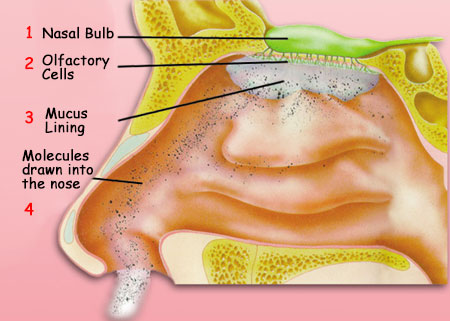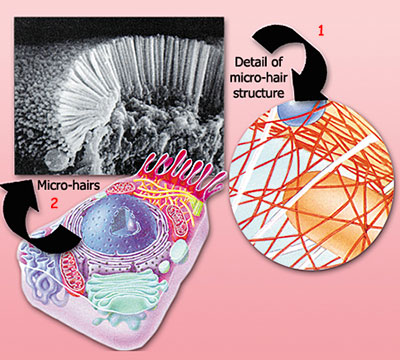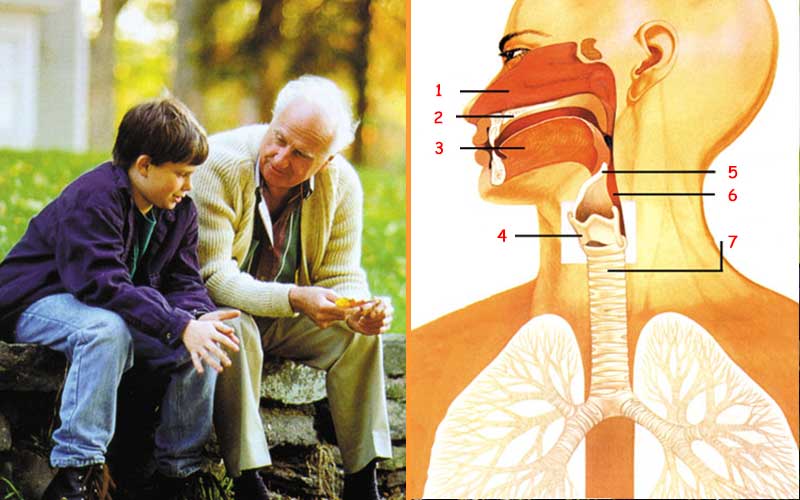Bigotry: The Dark Danger
The Human Miracle

DOWNLOAD THE BOOK
CHAPTERS OF THE BOOK
- Introduction: A Short Voyage Through The Human Body
- The Body’s Transport Network: The Circulatory System - 1/3
- The Body’s Transport Network: The Circulatory System - 2/3
- The Body’s Transport Network: The Circulatory System - 3/3
- The Digestive System - 1/3
- The Digestive System - 2/3
- The Digestive System - 3/3
- The Body's Purification Plant: The Excretory System - 1/2
- The Body's Purification Plant: The Excretory System - 2/2
- Splendid Communication within The Body: The Hormone System
- Your Internal Air-Conditioning: The Respiratory System
- A Resistant Structure: The Skeletal System
- Powerhouses in The Body: The Muscles
- Conclusion: Human Beings are Created By Allah
- The Deception of Evolution
< <
11 / total: 15
Your Internal Air-Conditioning:
|
|||||||||||||||||||||||||||||||||||||||||||||||||||||||||||||||||||||||||||||||||||||||||||||||||||
|
In the mother’s womb, babies are nourished by the oxygen they receive through the umbilical cord. Their bodily structures during that period have been created in such a way as to allow them to obtain oxygen without using their lungs. Gradually, however, their lungs grow, along with the other organs. The baby is unable to breathe while floating in the special amniotic fluid in the womb, but when it emerges, it starts using its lungs and breathing normally. All the preparations are readied for the baby before it is even born. All the organs it will require in the outside world are prepared for it while still in the womb. It is Allah Who creates human beings. This vital transition in the human body takes place smoothly thanks to the perfect system created by Allah. |
 |
Consider the smells of new-baked bread, honeysuckle in the garden, new-mown grass, rain-washed soil, meat cooked to perfection, fresh- picked strawberries, peaches and parsley, the soap you use, your fragrant shampoo and so many more: For all of these, you are indebted to the sensitive structure in your nose.
Few people ever consider the many smells they encounter during the course of the day, nor how these are shaped by the organs within their heads. Yet your sense of smell imparts the flavors to what you eat. Smell is one of the senses that let you identify objects.
Smells enter through the nose with every breath you take. The human nose possesses the impressive ability to analyze a scent in 30 seconds and to distinguish between some 3,000 different chemicals. 60
In the upper part of the nose, two small areas known as the olfactory epithelia contain a large number of nerve cells. These areas are responsible for scent perception. Scents move as molecules in the air. As you breathe, these molecules enter the nose alongside oxygen. When the scent molecules carried by the air reach the olfactory epithelium, the receptor cells there are stimulated and send an electrical signal to the brain. The brain deals not with the scent molecules directly, only with the electrical signals that reach it, and the brain’s interpretation of those signals is then perceived as smell.
Beyond just allowing us to enjoy the lovely scents of flowers or delicious foods, the nose has many other important functions, being the beginning of the respiratory passages one of the main conduits between the air we breathe and the blood that transports oxygen to cells throughout the body. When air enters the nose, it encounters tiny hairs known as cilia and is immediately subjected to analysis. Molecules in the air are separated out and examined, and the nature of their smell is forwarded to the brain and determined, all in as little as 30 seconds.
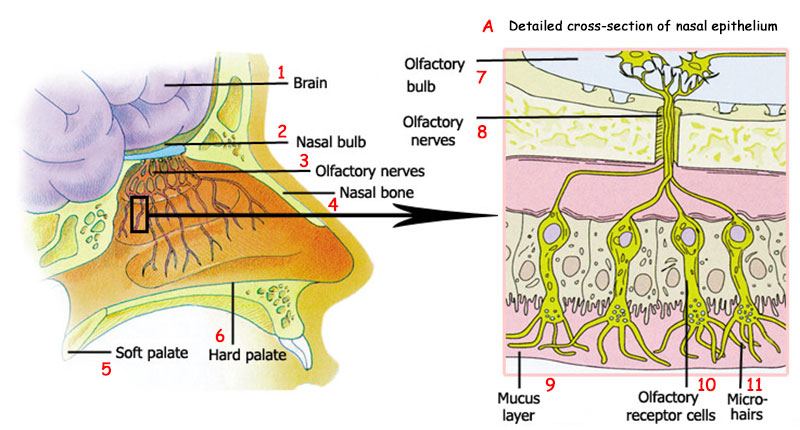 |
|
|
1. Brain |
A. Detailed cross-section of nasal epithelium |
|
It is not enough for the air we breathe to be cleaned of harmful substances. If it is to be used, it must also be warmed and moistened. The folds in the nasal passages possess the ideal system for warming air. Air caught in them is heated by the very fine blood vessels on the nose’s inner surface.The cool, dusty air you breathe in is thus warmed, filtered, cleaned and moistened before it ever reaches your lungs. Were that not so, and the air you breathe reached your lungs in its original chilling, drying state, you would also be exposed to serious infections in the lower parts of the lungs, since the air is full of bacteria. The superior creation in the nose protects you from that danger, however. |
|
There is also a flawless aerodynamic system in the nose. Air does not directly go to the lungs when it enters the nasal passages. Just like an air-purification unit, the nose prepares air which may be dirty, too hot, cold or dry, using very special filtering systems. Thanks to the special undulating structure in the nose, the air performs a sort of turn, making greater contact with the cilia and network of blood vessels. Thanks to its undulating structure, the air filters 15 cubic meters (19 cubic yards) of air a day,—about equivalent to the volume of air in a room—while cleaning, moistening and warming it.
The word “dirty” must not be taken as meaning only dusty, however. Together with the dust that enters with the air, some 20 billion foreign substances such as bacteria and pollen are prevented from entering the body by means of special system in the nose.
 |
|
Breathing takes place automatically. A person makes no effort to carry out this vitally important function, seldom makes any decisions regarding it and needs not intervene in it in any way. This miraculous system goes into operation from the moment you are born, and works without ever stopping. |
In his book Human Engineering, the evolutionist medical engineer John Lenihan compares the nose to an air-conditioning system, and describes its flawless creation:
The space behind the nostrils contains the world’s finest air-conditioning plant, combined with a detection system of extraordinary sensitivity, which analytical chemists are not yet able to explain, still less to imitate. . . . the air conditioning system of the nose is, in engineering terms, very well designed.61
Air, having deposited dust and all kinds of harmful bacteria inside the nose, then passes over the three undulating structures in each nostril. Any foreign bodies that attach themselves to the tiny hairs there are then neutralized by the antibacterial mucus there. As it meets these undulations, the air changes direction and strikes the mucosal fluid on the wall of the nose. The cleaning of the air is most wide-ranging, because if a bacterium or other harmful body were to enter such a sensitive organ as the lung, this could have damage the individual’s health. Yet if any harmful bodies nonetheless manage to pass through the nose, they are caught in the respiratory passages.
The cleaned air is now ready to pass to your lungs through the windpipe. But before we follow the air on its journey through the respiratory system, it will be useful to emphasize our air-conditioning analogy. An air-conditioning system also regulates air temperature. So, how did such a system come into being in the human body? How was it installed? How did it come to be present and fully formed in every human being?
Is it possible for all the components of such an air conditioning system to be the work of coincidences? Imagine that we place all the fully formed parts of an air-conditioning system into a room. Even if we re-enter that room one million years later, will we encounter a fully functioning air-conditioning system? Even if the system has come into being by itself, its parts will have long since rusted and broken down.
In order for any technical device to come into existence, there must logically be a talented maker, making a deliberate effort to put the component parts together in a specific order. Any logical person will agree with that. In terms of functioning, there is no difference between the air-conditioning in our bodies and those we are familiar with outside—and moreover, ours is far superior in its structure. The system’s inimitable creation belongs to Allah. Allah has created Man together with the most perfect systems for his survival. Allah is the flawless and peerless Creator of all.
He is Allah–the Creator, the Maker, the Giver of Form. To Him belong the Most Beautiful Names. Everything in the heavens and Earth glorifies Him. He is the Almighty, the All-Wise. (Surat al-Hashr: 24)
In The Respiratory Passages, Tiny Hairs are Able To Find Directions Impeccably |
||||
|
As you breathe air, you actually inhale a great many harmful substances. Yet these have no effect on you, since they are caught and neutralized at specific security checkpoints before ever reaching your lungs.
The surfaces of all respiratory passages, from the nose to the bronchia, are covered in a layer of mucus, that moisturizes the passages and thus traps tiny particles breathed in with the air, preventing them from entering the lungs. However, foreign bodies trapped in the mucus must be expelled or they will gradually accumulate in the respiratory passages. To effect that, another security mechanism in your body goes into operation. Pointed whips or flagella known as cilia cover the surfaces of the respiratory passages. There are 200 of these cilia on every cell on the surfaces of the respiratory passage. The cilia in this region beat 10-20 times a second, setting up a constant motion in the direction of the pharynx. They thus permit the mucus containing foreign bodies to move always towards the pharynx at a speed of 1 centimeter (0.4 inch) per minute. Cilia above in the nose, knowing that the mucus in this region must now proceed downwards, set up a whipping motion in the exact opposite direction, thus permitting the dust-laden mucus to reach the pharynx. In this way, the entrance to the respiratory system is purified of foreign bodies. As these examples show, the tiny cilia have no eyes, ears, brains, yet can identify the location of the pharynx, which is proportionately thousands of kilometers away from them. In addition, they know that foreign bodies allowed to proceed to the lungs will harm the body, and they all move together, in coordination, in the proper direction to prevent this happening. These tiny hairs, no longer than 1/2 millionth of a meter, have the kind of working mechanisms scientists have been unable to unravel fully despite all their various experiments and long years of research. It has been working flawlessly ever since the first human came to be. Since they act under the inspiration of Allah, Who created them, they possess a perfect functioning that no chain of coincidences could ever have created. |
||||
The Windpipe’s Vital Passageway
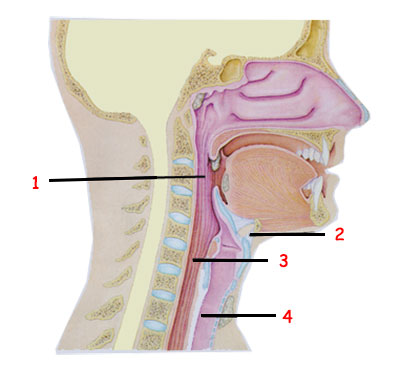 |
|
|
1. Middle Pharynx |
3. Esophagus |
|
The upper respiratory passages in the nose |
|
In the next stage of the respiratory process, the clean air from the nose will descend further down, into the windpipe.
Examined under the microscope, the windpipe reveals a structure that protects the lungs by constantly cleaning itself. The windpipe’s interior is carpeted in vibrating hairs with a link-like structure. These tiny hairs engage in a constant whip-like motion away from the direction of the lungs, and toward the mouth. Smaller particles falling onto them are thus propelled up the throat, away from the lungs. The windpipe joins the esophagus in the throat region and propels the accumulated waste particles and bacteria that could lead to sickness in the lungs into the esophagus, where they are swallowed in to the stomach; where the stomach’s gastric acid destroys them. When you wake up in the morning, the reason for your feeling a fullness in your throat and hearing your voice altered is that foreign bodies and bacteria accumulated in your windpipe during the night-long cleaning process.
That is by no means the end of the safety systems protecting the lungs. If liquid or pieces of food chance to enter the windpipe, these are expelled by the explosion of air known as a cough, which can expel air at a speed of 960 kilometers/hour (596 miles an hour). 62
The windpipe is a tube of some 30 centimeters (11.8 inches) long that runs from the throat to the lungs. The tube must always be open, or else the individual will suffocate. But it is not easy to make sure that this flexible tube running through such a mobile region as the neck is kept open constantly. Thanks to the windpipe’s perfect creation, however, it has been reinforced with C-shaped cartilage that prevents the windpipe from closing.
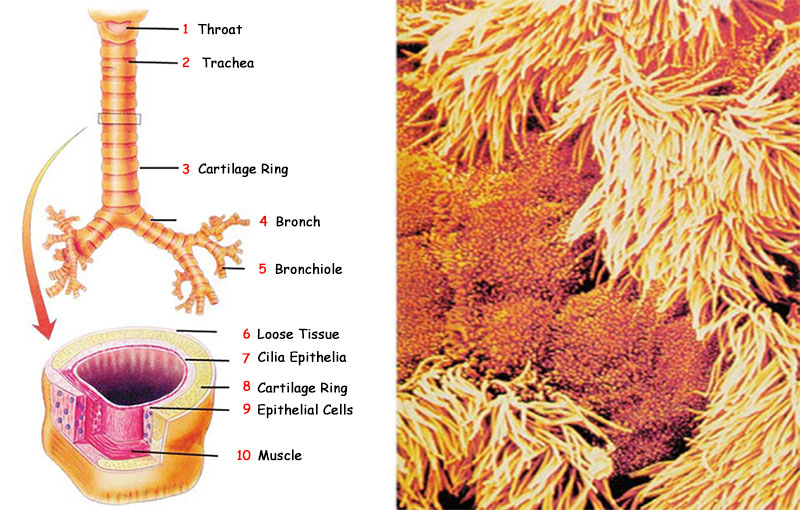 |
|||
|
1. Throat |
4. Bronchus |
6. Loose Tissue |
9. Epithelial Cells |
|
Above shown the tiny hairs in the respiratory passage as seen under an electron microscope, and at right, the general structure and a cross-section of the respiratory passage. |
|||
The absence of any one aspect of this complex system would lead to irreparable harm. Kartagener syndrome, for example, is a genetic disease, in which all the components of the system are present, but the tiny hairs coating the windpipe lack the ability to move. The great majority of babies born with this deficiency suffer recurrent lung infections and die before reaching childhood.
These micro-hairs in the depths of the human body, invisible to the naked eye, work with all their might for the body’s health, literally transporting the dust and foreign bodies away from the lungs. The billions of micro-hairs, which you are never aware of but which work night and day on your behalf, are proofs that the human body was created.
The Mere Existence of The Microscopic Hairs That Cause The Cells To Act is Sufficient To Refute The Myth of Darwinisms |
|||||
|
Darwinists would have us believe that all life came into being as the result of uncontrolled coincidences. But the thousands of details in the structure of the micro-hairs, whose sole function is to cleanse the esophagus refute this myth: Thanks to micro-hairs, certain cells act rather resembling eyelashes. For example, every fixed cell in the respiratory passage contains hundreds of such hairs.
These hairs all move at the same time, just like oarsmen in a scull, to move the cell forward. When one of these hairs is cut in cross-section, it is seen to consist of nine separate microscopic rods, called micro-tubes. Micro-tubes are made up of proteins known as tubulin. These micro-tubes, in turn, consist of two interconnected links. One of these links consists of 13 fibers, the other of nine. Each micro-tube has two extensions known as the inner and outer arms, which contain a protein called dynein—whose function is to set up a mechanical force and to serve as an engine between the cells. The molecules comprising the protein tubulin are laid out like bricks, forming a cylindrical pattern within the cell. The sequence of tubulin molecules is far more complex than that of bricks, however. In the middle of the micro-hairs are two more micro-tubes that stand alone and consist of 13 strands of tubulin. Each tubulin has 10 protrusions on its upper part and 10 indentations on the bottom. These have been created to be compatible with one another, and thus set up a very solid structure. The slightest defect in the very special creation of these protrusions and indentations will harm the structure of the cell. These components which we have just described in very general, simple terms give rise to the micro-hair. Their sole purpose is to cause just one of the trillions of cells in your body to move. Everyone who has ever lived has possessed just such a wide-ranging system in their respiratory cells. In addition, these hairs’ complex and numerous parts have further substructures. In short, Allah has installed an exceedingly systematic and complex mechanism inside an area that we can effectively refer to as taking up no space at all. It is absolutely impossible for cells to coincidentally install such a system in such an inconceivably tiny space. This is possible only by means of Allah’s superior and infinite intellect, knowledge and power. |
|||||
Could You Make a Device to Clean Your Own Blood?
The oxygen that passes through the windpipe moves down through the two bronchia that lead to the two lungs on the right and left of the chest cavity. The lung is one of the most important organs in the whole body. In addition to its blood-vessel connections to all the other organs, it possesses its own exceedingly complex internal creation.
Before detailing the lung’s structure, consider how any production is implemented.
The first stage consists of a specific plan, following which specific components are brought together. Looking around you, you will see many products of design—on the cover of this book, in its internal layout, and in its subject matter. The paper this book consists of, the clothes you have on, and the chair you are sitting in are all products of design. As the detailed evidence presented in this book so far, there is also obvious creation in the human body.
Now, imagine that you’re asked to make a human body.
You must plan a device that will clear the carbon dioxide from the blood and replace it with oxygen. But that device also has to be small enough to fit into a human body.
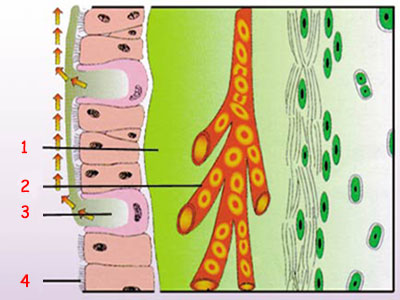 |
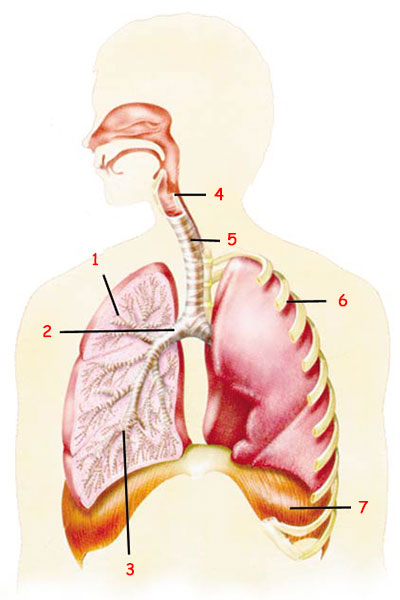 |
|
|
1. Cartilage |
3. Blood Vessels |
|
|
The upper respiratory passages in the nose |
||
|
1. Lung with air sacs visible |
5. Windpipe |
|
In order to make it, first you need to know thousands of details about the chemistry and behavior of oxygen and carbon dioxide, how oxygen is transported in the blood, the structures of the molecules that do the carrying, and oxygen’s atomic properties. It is totally impossible for you to make the required device without that information.
If you engage in wide-ranging research into blood and oxygen, you will conclude that in order for the CO2 in the blood and the O2 in the air to change places, then the blood and the air need to make contact with each other over as wide an area as possible. This area must be at least 100 square meters (119 square yards) in size. In other words, the device you need to make must place blood and air in contact over that wide an area, but also must be small enough to fit into the human body. No doubt that a very superior intellect is required to possess the knowledge to make such a device.
Call together the world’s most expert designers to produce such a mechanism, using the most up-to-date technology. Yet no matter how hard you try, you will never be able to make a device produced as perfectly as your own lungs.
What kind of technology must there be for the lungs’ surface area of 100 square meters (119 square yards) to be packaged and installed? To answer that question, we must examine the lungs’ miraculous properties.
|
1. Bronchus |
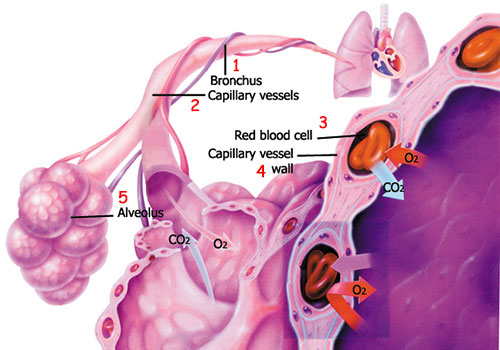 |
|
Oxygen enters your body through the alveoli in your lungs. These delicate air sacs are surrounded by capillary vessels the width of a cell. |
Perfect Creation in the Micro-Sacs
Examining the lung, you encounter a flawless structure created to bring together oxygen and carbon dioxide.
Inside the lung are more than 300 alveoli, each no larger than the tip of a needle, with a diameter of just 0.25 millimeter (0.01 inch). When the total area occupied by these alveoli is calculated an astonishing figure emerges. The surface area of the human lung is between 70 and 100 square meters (83 and 119 square yards). The squeezing of such a large surface area into such a small volume is the work of an impeccable creation.
There are blood vessels on the inner surfaces of these 300 million alveoli. Every time you breathe, the alveoli fill with air, and the carbon dioxide in those blood vessels changes place with the oxygen atoms in the air.
However, it is not as easy for these air sacs to open and close as might appear. In the same way that it is difficult to inflate a balloon for the first time, so it is just as hard to inflate alveoli, which possess very high tension under normal conditions. Yet you experience no difficulty in breathing in and out. You don’t even feel our alveoli opening and closing, because your respiratory system’s creation allows you to breathe with ease. The absence of a system that allows the alveoli to open and close easily with each breath would lead to such serious, if not fatal problems.
As always, the very best creation possible has been placed at our disposal.
The surfaces of the more than 300 million alveoli in your lungs are covered in a substance known as surfactant, which helps the alveoli open and close and reduces surface tension.63 Another function of this substance is to prevent the alveoli from closing fully during exhalation. Thanks to surfactant, a certain amount of air remains in the lung even after the most powerful exhalation. In this way, blood circling around the alveolus is always in contact with the air and thus regularly transports oxygen to the body’s cells.
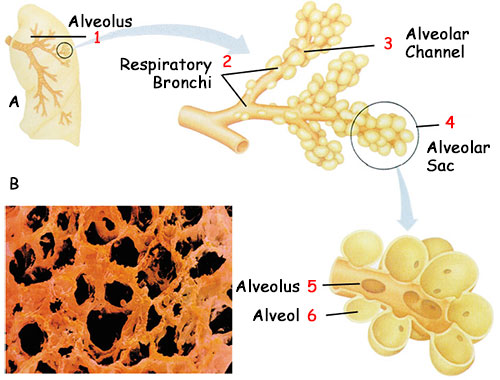 |
1. Alveolus |
|
Components of the region where respiration takes place: |
Surfactant is synthesized by a very special group of cells, called type II granular pneumocytes, on the surface of the alveoli. Thanks to these cells, not found anywhere else than in the lungs, you can inhale and exhale with no difficulty.
One of this substance’s miraculous aspects is that it begins to be produced a month before a baby is actually born. How can a baby in the womb, where it does not need to use its lungs, realize that it will face such a difficulty in the outside air and needs to produce this substance? How does it know that surfactant will help the air sacs in its lungs? What chemical knowledge does it use to calculate that it will reduce the alveolis’ surface tension? The absence of this surfactant will soon cause the newborn to die. In exceptional circumstances where this precaution is not taken—for instance, in premature babies, when insufficient surfactant is produced—the result is oxygen insufficiency. 64
This sensitive equilibrium seen at every point in the human body is an important example of the perfection of Allah’s creation of living things. With His infinite might, He has created every living thing with incomparable forms. The duty of anyone taking a further step toward knowledge of Allah is to properly appreciate His might and to fear Him accordingly.
He has given you everything you have asked Him for. If you tried to number Allah’s blessings, you could never count them. Man is indeed wrongdoing, ungrateful. (Surah Ibrahim: 34)
The Body’s Eternal Flame: Respiration
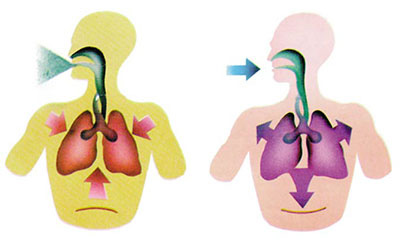 |
|
Without your ever being aware of it, there is a constant exchange of oxygen, carbon dioxide and water in your body. Around 1 trillion air molecules enter the body every time you inhale. |
In many respects, the process of respiration can be compared to oxidation, as in a burning fire. Compared to fire, however, respiration is a chemical process that takes place slower and at lower temperatures.
Your cells “burn” the carbon in nutrients by using the oxygen in the air, producing the energy your body needs. That is why it wouldn’t be inaccurate to describe the phenomena that take place after every inhalation as the smoldering inside you of billions of little sparks.
Every one of the cells in your body requires a constant supply of oxygen. For example, because the billions of cells on the retinas of your eye are kept constantly fed with oxygen, you are able to read this book. In the same way, all the cells that make up the muscles in your body obtain energy by burning carbon compounds—in other words, by reacting them with oxygen. Every time you inhale, some 100 trillion air molecules enter your lungs. of these, around 21% or 21 trillion, are oxygen molecules. Having entered your body by way of the respiratory system, these molecules are carried by the bloodstream to the furthest points in your body, and change places with the CO2 dioxide molecules there. Although you may imagine that you are simply inhaling, there is actually a constant exchange of O2, CO2 and water going on in the depths of your body.
Oxygen Bearers
The principal aim of respiration is to expel the CO2 in your cells and replace it with oxygen. This process actually takes place far from the bodily tissues—in the lungs. That being so, the O2 entering your lungs must somehow be transported to the tissues, and the CO2 forming in the tissues carried to the lungs. How does that transportation take place?
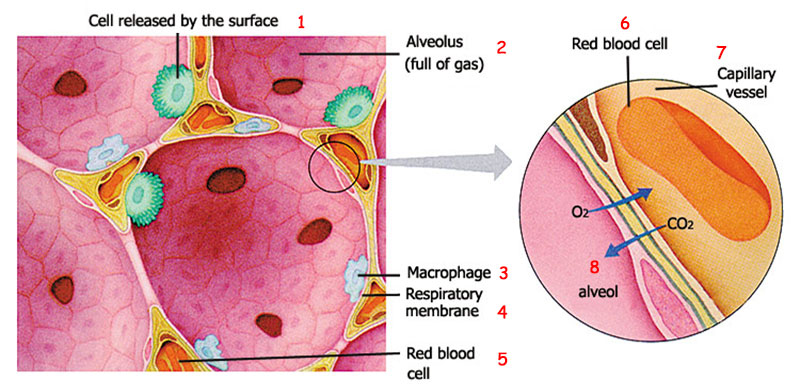 |
|
|
1. Cell Released By The Surface |
5. Red Blood Cell |
|
The anatomical structure of the respiratory membrane is shown to the above left. Oxygen enters the capillary vessels in the bloodstream through the alveoli; carbon dioxide enters the alveoli from the blood. The alveoli are connected to one another by minute gaps. The picture to the right shows these gaps in detail. |
|
The indefatigable carriers of both molecules are the erythrocytes in the blood. Erythrocytes that come into contact with the air sacs in the lungs release the waste-product CO2 they are carrying and absorb the O2 in them. This process takes place along a very special membrane: On one side of this membrane is the oxygen-rich air inside the air sacs (alveoli), and on the other, there are capillary protrusions only wide enough for just a single erythrocyte to pass. The O2 molecule is thus able to contact the erythrocytes with no difficulty.
The O2 molecule is carried to the cells by hemoglobin, a molecule inside the erythrocyte—whose external appearance resembles a saucer, ideally shaped for carrying O2 or CO2. Hemoglobin binds with oxygen in the lung and sets out for the deepest recesses of the body by way of the red blood cells. When they reach tissues that need oxygen, a miracle takes place. The hemoglobin molecule, with its very special creation, is chemically affected by its environment. The chemical link between it and the O2 is broken. As a result of this, the hemoglobin releases its load of oxygen molecules to the cells there.
 |
|||
|
1. Alveolus |
2. Erythrocyte |
3. Capillary Vessel |
4. Body Cells |
|
The carrying of oxygen and carbon dioxide takes place in this way: |
|||
Nor is that the end of hemoglobin’s functions. It also transports back to the lungs the CO2 that needs to be carried away. To sum up this process:
The CO2 that emerges from cell respiration passes to the tissue fluid, and from there to the capillary vessels. Part of the CO2 molecule attaches to the erythrocytes’ hemoglobin and is carried in the form of carbamino hemoglobin. Another part turns into carbonic acid by combining with water under the effect of an enzyme, carbonic anhydrase. Later, the carbonic acid divides into bicarbonate and hydrogen ions; and the hydrogen ions are caught by the hemoglobin. In this way the CO2 is brought from the tissue capillaries via the veins to the heart, and then to the lungs. Following a number of processes in the lung, the carbon dioxide is finally expelled during exhalation. 65
There is yet another noteworthy feature in the structure of hemoglobin. In the same way that it possesses the ability to transport O2, hemoglobin also possesses the ability to carry that oxygen to just the right destination, thanks to a chemical link between hemoglobin and oxygen. To emphasize the importance of this property of hemoglobin, the following analysis will be useful:
If the link between hemoglobin and oxygen were slightly weaker, hemoglobin could not bind to O2, and the latter could not reach the tissues—spelling death for living things.
If the exact opposite were true—and the link between hemoglobin and O2 were any stronger—then the two could not separate once they reached the tissues. The cells would be deprived of oxygen, and would expire within a few minutes.
This offers clear evidence that hemoglobin is specially created as a perfect system for transporting O2 in the human body. Every detail within that system is proof of the infinite nature of Allah’s knowledge and power. There is an infinite range of possible molecular attractions between hemoglobin and O2. Yet the most ideal of all of these attractions has been established between the two—neither too strong nor too weak, but at just the right level. This cannot have come about by chance, but is clearly the product of a deliberate creation.
Any defect or deficiency during the production of a molecule, during the respiratory process or the pumping of the blood, any change in the blood’s contents (a simple kidney problem is enough for that to happen), will lead first to severe illness, then to death. That being so, none of the components making up this system could have come into being of its own accord. All must have come into existence at the same moment, within the same body. And this applies not just to the process of O2 transport in a single cell, but to every individual process in all the trillions of cells in all the billions of people on Earth.
As you’ve seen, hemoglobin carries oxygen from the lungs. Yet the production of this complex molecule is entirely under the control of the bone marrow. Can the bone marrow cells know about an organ so very distant from them and to decide to initiate processes according to its requirements? It would clearly be quite irrational to maintain so.
Evidence of an incomparably superior Intellect can be seen in every detail of the respiratory system. The existence of that system—so complex and yet so perfect—can never be explained in terms of random coincidences. The only explanation is creation. Out of nothing, Allah has created humans with their flawless bodily structures.
It is He Who created the heavens and the Earth with truth. The day He says ‘Be!’ it is. His speech is Truth. The Kingdom will be His on the Day the Trumpet is blown, the Knower of the Unseen and the Visible. He is the All-Wise, the All-Aware. (Surat al-An‘am: 73)
Details of the Superior Creation in the Lungs
To Breathe In and Out, the Lung Needs an External Power Source
Human beings are unaware of what happens as they breathe. The way respiration accelerates as they run or slows during sleep, is nothing extraordinary. Yet the way that inhalation and respiration regulate themselves is a miracle all by itself.
The lungs pump air in and out for a whole lifetime, and in order to function, the lungs—just like all other organs—need energy from outside. That is provided by the rib muscles, directly underneath the ribcage, in the diaphragm. When you inhale, the ribs move outward and upward. The lung pulls the air down the windpipe. When you exhale, the ribs are pulled back in, while the diaphragm muscle beneath the ribcage moves up. As the lungs contract, air in the tiny air sacs is pressurized and departs up through the windpipe.
You can make no contribution at all to these activities inside your body. You can give no instructions nor contribute to how your muscles work. Neither do you have any need to do so, because the energy for your lungs has been provided by a superior Intellect.
Expansion of the Ribcage Facilitates Breathing
The ribcage plays a very important role in the respiratory system, but this structure’s best-known feature is the way that it protects the internal organs, especially the heart and lungs. Yet the ribcage’s flexible nature is also important in facilitating breathing.
When you inhale, the armor plating of your bony ribcage possesses a surprising elasticity. The ribcage, which under normal conditions resembles a hard protective shield, is astonishingly flexible. However, if the ribcage were just a little less flexible than it is, the lungs could not expand and you could not breathe comfortably. Allah has created that flexibility in an ideal form that is neither too much nor too little—a blessing for human beings.
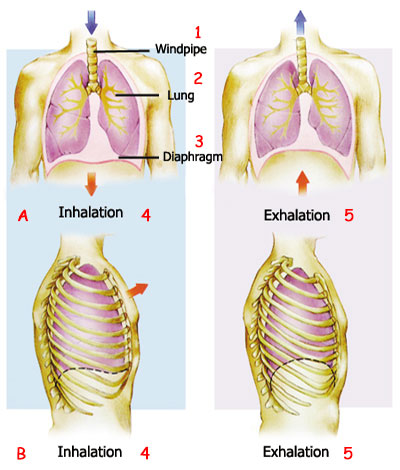 |
1. Windpipe
4. Inhalation |
||
|
Every time you breathe, the diaphragm and chest cavity move. A- Changes in the position of the diaphragm and the volume in the chest cavity during inhalation and exhalation B- Changes in the position of the chest cavity during inhalation and exhalation. Air fills the lungs when the volume of the chest cavity increases. |
The System of Shock-Absorbers in the Lungs
The ribcage’s protection against external blows, the hairs in the windpipe that prevent dust entering from the outside, the nasal mucus that regulates the temperature of inhaled air and traps germs, the production of surfactant that eliminates surface tension in the air sacs, and many more such details—these are hardly all the systems in place to safeguard the lungs. A different protection mechanism also prevents friction between the lung surface and other organs.
The external surface of the lung is covered in a layer of membrane (pleura), so that the lung is never harmed as you breathe in and out. The pleura surrounding each lung just like bags is in contact with another membrane covering the chest wall and the internal surface of the diaphragm, with slippery liquid between them. The outer surface of the lung thus never makes contact with any other organ during respiration, and the lung is protected from friction. 66
In addition, the negative pressure or vacuum between the membrane covering the lung and the one surrounding the chest wall causes the lung to adhere to the chest wall. This allows the lung not to be crushed by its own weight. If the lung’s vacuum environment is impaired for any reason—in a traffic accident for instance, or when a sharp object pierces the chest wall—the lung deflates like a balloon and with a so-called “collapsed lung,” the individual may die. 67 This system is another indication of the lung’s splendid creation.
 |
|
|
a. O2 absorption |
i. Cleansed blood is sent from the lungs to the heart and then distributed to the body
l. CO2-laden blood goes from the tissues to the heart, and from there to the lungs. |
|
Respiration takes place with the control mechanism shown above.
Consider how many times you breathe each day. All these processes take place to perfection every time. Any confusion in the order or any deficiency would mean you could not receive oxygen. All these processes, described in brief and which take place without exception at every moment, happen by the leave of Allah. |
|
The Automatic Regulation of Breathing
The frequency and depth of the respiration varies according to the body’s activity and the surrounding environment. For example, anyone who is running or climbing stairs breathes faster and more deeply than one sitting down, because muscle cells expend more energy while the body’s in motion. The body’s trillions of cells therefore need more O2 than usual. In addition, the excess CO2 produced by the cells must also be expelled. If the increasing oxygen demand is not met, all the cells will suffer. The cells in such regions as the brain and heart, which have a low tolerance for lack of oxygen, will soon lose all their vitality.
In order to provide more O2 and remove more CO2 than normal, the only solution is to accelerate the respiratory system by ensuring that the lungs work faster. A special system must therefore come into operation to bring that about. And indeed, the respiratory system indeed possesses a miraculous system that comes into operation at times of sudden need.
Respiration is controlled by centers in the brain via the spinal cord. Nerves going to the diaphragm and rib muscles ensure that these structures contract at a regular rates of 4 to 5 times a second. If these nerves are cut, then respiration comes to a stop.
Another factor that influences respiration is the level of CO2 in the blood. In situations where the metabolism hastens, the CO2 level also rises. As a result, blood acidity rises and therefore, blood pH drops, which affects the respiratory center in the nervous system. These centers in turn stimulate the diaphragm and rib cage by means of the nerves to accelerate respiration. Oxygen is taken in and CO2 expelled more quickly. The level of carbon dioxide in the blood is thus returned to normal, and blood pH is adjusted.
If respiration increases more than necessary, the brain stem makes the requisite adjustments. In addition, pressure-sensitive receptors on the outer face of the lung send the necessary instructions to the brain stem, telling it to not to breathe so deeply, since the lung is expanding more than it needs to. 68
As you see, this system is interconnected in all respects. Therefore, the nervous system, respiratory center, diaphragm and all the other components must have emerged at once. In order for respiration to be automatically regulated, therefore, the system has to exist fully formed, as an integral unit. In other words, all its components have to be present all at once, appearing at the same time.
According to the theory of evolution, none of these details in the lung existed in the beginning. Each one of these flawless features formed gradually by means of coincidences. Yet that claim is in obvious conflict with both science and reason. First of all, for a human being to breathe, all the features in the lung just described must have existed right from the beginning, in the first human being who ever lived. For example, ribs whose cartilage “hinges” lacked elasticity, or a lung that lacked alveoli or the surfactant around those alveoli, or with no protective membrane around it, would serve no purpose. It is impossible for evolution’s chance mechanism to bring any organ into being or to let it acquire any features. That will never change, not even over hundreds of millions, or even trillions of years.
These details in the human body are some of the proofs of Allah’s existence. Allah, Who has no partners in creation, builds this interconnected order. Allah is the Almighty, Who has knowledge of all forms of creation.
Your Lord is Allah, Who created the heavens and the Earth in six days and then settled Himself firmly on the Throne. He covers the day with the night, each pursuing the other urgently; and the sun and moon and stars are subservient to His command. Both creation and command belong to Him. Blessed be Allah, the Lord of all the worlds. (Surat al-A‘raf: 54)
Have You Ever Thought How Your Every Word is The Result of a Miraculous System? |
||||||||
|
The moment you wish to speak, a series of commands travels from your brain to your vocal cords, and from there to your tongue and the muscles in your jaw. That part of your brain containing the speech centers sends the needed instructions to all the muscles that play a role in the speech process. First of all, the lungs provide warm air, the raw material of speech. Air that enters through your windpipe to the lungs. The oxygen in the air mixes with the blood in the lungs, and carbon dioxide is emitted at the same time. Carbon-dioxide laden air returning from your lungs passes through your throat and between two twists of tissue known as the vocal cords, which move according to the effect of the minute cartilages to which they are attached. Before you begin speaking, your vocal cords are open and apart from each other. When you speak they come together and vibrate in the flow of air you breathe out.
The structure of your mouth and nose gives your voice its own particular quality. As you speak and form words, one after the other, your tongue rises toward and moves away from your palate, and your lips purse and relax. During this process, a great many muscles perform at unbelievable speed. In order for you to speak, each process must take place without any components going wrong. These processes occur at great speed and with extraordinary perfection, without you even being aware of them. This complex system of speech is one example of the matchless creation that the theory of evolution can never account for. The emergence of this speech cannot be explained in terms of “chance” evolution. On the contrary, it once again reveals that our bodies were created by an almighty Creator—in other words, Allah—and were given us as a blessing. Thanks to this system created for you by Allah, you are able to express the thoughts that come to your mind. Use this blessing to tell others of the greatness and might of Allah! |
||||||||
Footnotes
60.John Farndon, Angela Koo, Human Body Fact Finder, p. 188.
61.John Lenihan, Human Engineering, New York: John Braziller, 1974, p. 94. 
62.Discovery Channel, Human Machine, Breath of Life 
63. Eldra Pearl Solomon, Introduction to Human Anatomy and Physiology, p. 202 
64. Arthur C. Guyton and John E. Hall, Textbook of Medical Physiology, Guyton & Hall, 9th. edition, p. 541. 
65.Biological Science: A Molecular Approach, Sixth Edition, p. 478. 
66. Eldra Pearl Solomon, Introduction to Human Anatomy and Physiology, p. 204. 
67.Marshall Cavendish, The Illustrated Encyclopedia of the Human Body, p. 91. 
11 / total 15
You can read Harun Yahya's book The Human Miracle online, share it on social networks such as Facebook and Twitter, download it to your computer, use it in your homework and theses, and publish, copy or reproduce it on your own web sites or blogs without paying any copyright fee, so long as you acknowledge this site as the reference.
